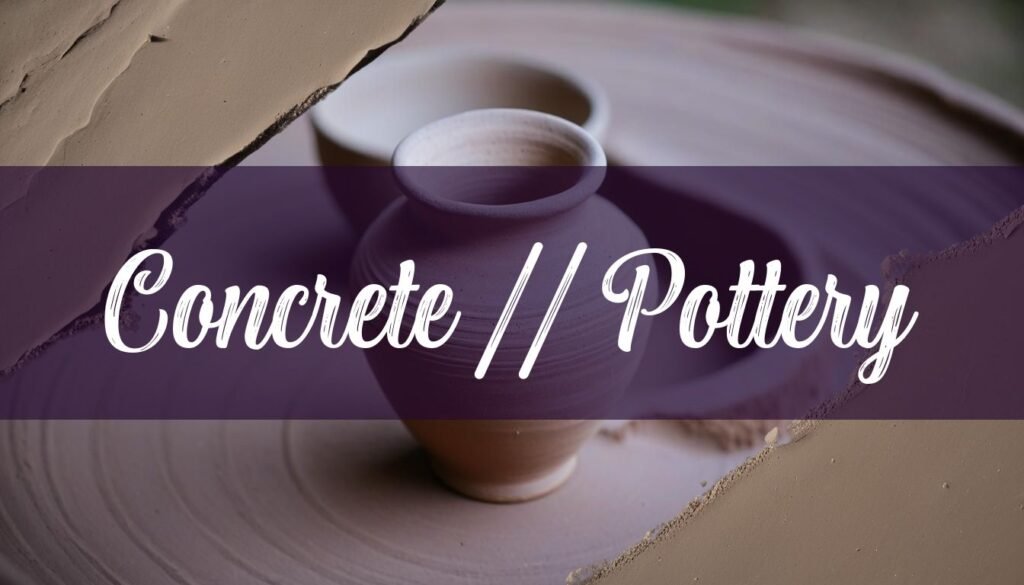Making concrete pottery at home is a rewarding endeavor that combines the rustic charm of concrete with the artistic expression of pottery. Perfect for beginners, small to medium-sized concrete projects offer a fantastic way to explore this versatile material and create unique decorative items, planters, and more. This guide will walk you through the essential steps, from gathering your materials to finishing your concrete creations, ensuring a smooth and enjoyable experience.
First, let’s gather the tools and materials needed for creating concrete pottery. A comprehensive list includes: various tools such as rolling pins, wooden paddles, wire clay cutters, scoring tools, trimming tools, potters knives, brushes, and sponges. You’ll need a suitable concrete mix, selecting one that suits your project’s needs. Also, you’ll need molds in desired shapes, mixing tools, safety gloves, dust mask, and eye protection. Don’t forget about sandpaper, sealant, and paint for finishing touches. Sources for these materials range from local hardware stores to online suppliers. Having all your materials ready will streamline the process and set you up for success.
Different Types of Concrete Mixes
Choosing the right concrete mix is crucial for your pottery project. Several options cater to different needs, each with its unique properties. For those looking for a quick turnaround, fast-set mixes are ideal because they contain special chemicals that accelerate the curing process. Rapidset Cementall is a favorite among crafters, known for its versatility and ability to cure much harder than regular concrete, reaching up to 9000 psi compressive strength. It’s super fine, ensuring detailed impressions and a smooth, white finish. Quikrete Fastset AllCrete shares similar qualities, offering workability at various consistencies, but it cures to a darker, true concrete gray. For projects requiring a longer working time, Quikrete Vinyl Concrete Patcher provides about 30 minutes of work time and hardens in 24 hours. It contains additives that enhance strength. Another bonding mix, Sakrete Top’n Bond, performs similarly to Quikrete Vinyl Patch, making it suitable for building around shapes or casting thin leaves.
Alternatively, you could use a concrete mix (cement, sand and gravel) and the finished product will be stronger. Plain old portland cement is also an option, and Quikrete makes a packaged product that contains smooth, porous, and no obvious large rocks or holes. When mixing, remember that cement by itself tends to crack, so adding sand or aggregate provides additional binding strength. The main ingredient in concrete is Portland cement, a ceramic material that, when mixed with water, forms a paste that hardens through a process called curing. By adding materials like sand, rocks, or fibers—known as reinforcements—concrete becomes even stronger and more durable. Consider exploring what type of clay is used for ceramics in order to gain more understanding of pottery as a whole. For those interested in gardening with their pottery, check out this article on crafting planters and bonsai pots.
The Pottery-Making Process
With your materials prepared, it’s time to dive into the process of making concrete pottery. Begin by preparing your mold. Whether you’re using plastic containers, cardboard forms, or silicone molds, ensure they are clean and lightly oiled to prevent the concrete from sticking. Next, mix your concrete according to the manufacturer’s instructions. The consistency should be similar to thick oatmeal—pourable but not too runny. Carefully pour the concrete into your mold, filling it to the desired level. Gently tap the mold to release any trapped air bubbles, ensuring a smooth surface.
Now comes the waiting game: curing. Cover your mold with plastic to retain moisture and allow the concrete to cure for at least 24 to 48 hours. Curing is a critical process where the Portland cement, a ceramic material, hardens when mixed with water. Once cured, carefully remove the concrete piece from the mold. If you encounter any rough edges or imperfections, use sandpaper to smooth them out. At this stage, you can also drill drainage holes for planters, if needed.
Finishing Techniques and Troubleshooting
The final touches can transform your concrete pottery from simple to stunning. Sanding is essential for achieving a smooth surface, removing any imperfections or sharp edges. For sealing, apply an acrylic sealer to protect the concrete from moisture, stains, and UV damage. This will enhance longevity and resist staining over time. When selecting your materials, it’s helpful to research various concrete sealers and choose one that meets your specific needs. Painting offers another avenue for customization, allowing you to add color, patterns, or even mimic the look of traditional pottery. Before painting, ensure the concrete is clean and dry, and use a primer for better adhesion. Experiment with different textures by adding aggregates to your concrete mix or using textured molds. Lace tape can be used to create a surface texture.
Common issues include cracking, which can often be prevented by proper curing and avoiding rapid temperature changes. Minor surface cracks and tiny chips are typically easily handled with basic tools and materials. Elevating concrete planters is essential to creating better drainage. Place pots up on feet or plant stands, if available. Without sealing, it can absorb moisture and other substances, potentially leading to undesirable effects such as staining or degradation. Sealing acts as a protective barrier, significantly decreasing the material’s porosity.
With these steps, you’re well on your way to creating beautiful and durable concrete pottery. Experiment with different molds, mixes, and finishing techniques to discover your unique style. Whether you’re making planters, bowls, or decorative items, the possibilities are endless, and the satisfaction of crafting something with your own hands is truly rewarding.





